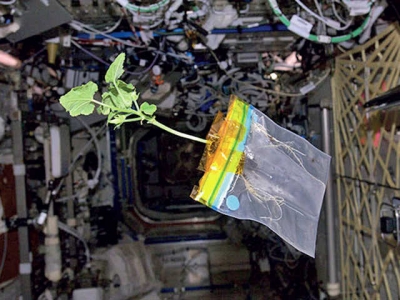
In 1982, the crew of the Soviet Salyut 7 space station conducted an experiment, prepared by Lithuanian scientists (Alfonsas Merkys and others), and grew some Arabidopsis using Fiton-3 experimental micro-greenhouse apparatus, thus becoming the first plants to flower and produce seeds in space.
Plant research continued on the International Space Station. Biomass Production System was used on the ISS Expedition 4. The Vegetable Production System (Veggie) system was later used aboard ISS. Plants tested in Veggie before going into space included lettuce, Swiss chard, radishes, Chinese cabbage and peas. Red Romaine lettuce was grown in space on Expedition 40 which were harvested when mature, frozen and tested back on Earth. Expedition 44 members became the first American astronauts to eat plants grown in space on 10 August 2015, when their crop of Red Romaine was harvested. Since 2003 Russian cosmonauts have been eating half of their crop while the other half goes towards further research. In 2012, a sunflower bloomed aboard the ISS under the care of NASA astronaut Donald Pettit. In January 2016, US astronauts announced that a zinnia had blossomed aboard the ISS.
In 2017 the Advanced Plant Habitat was designed for ISS, which was a nearly self-sustaining plant growth system for that space station in low Earth orbit. The system is installed in parallel with another plant grown system aboard the station, VEGGIE, and a major difference with that system is that APH is designed to need less upkeep by humans. APH is supported by the Plant Habitat Avionics Real-Time Manager. Some plants that were to be tested in APH include Dwarf Wheat and Arabidopsis. In December 2017 hundreds of seeds were delivered to ISS for growth in the VEGGIE system.
In 2018 the Veggie-3 experiment at the ISS, was tested with plant pillows and root mats. One of the goals is to grow food for crew consumption. Crops tested at this time include cabbage, lettuce, and mizuna. In 2018, the PONDS system for nutrient deliver in microgravity was tested.
Picture Credit : Google




